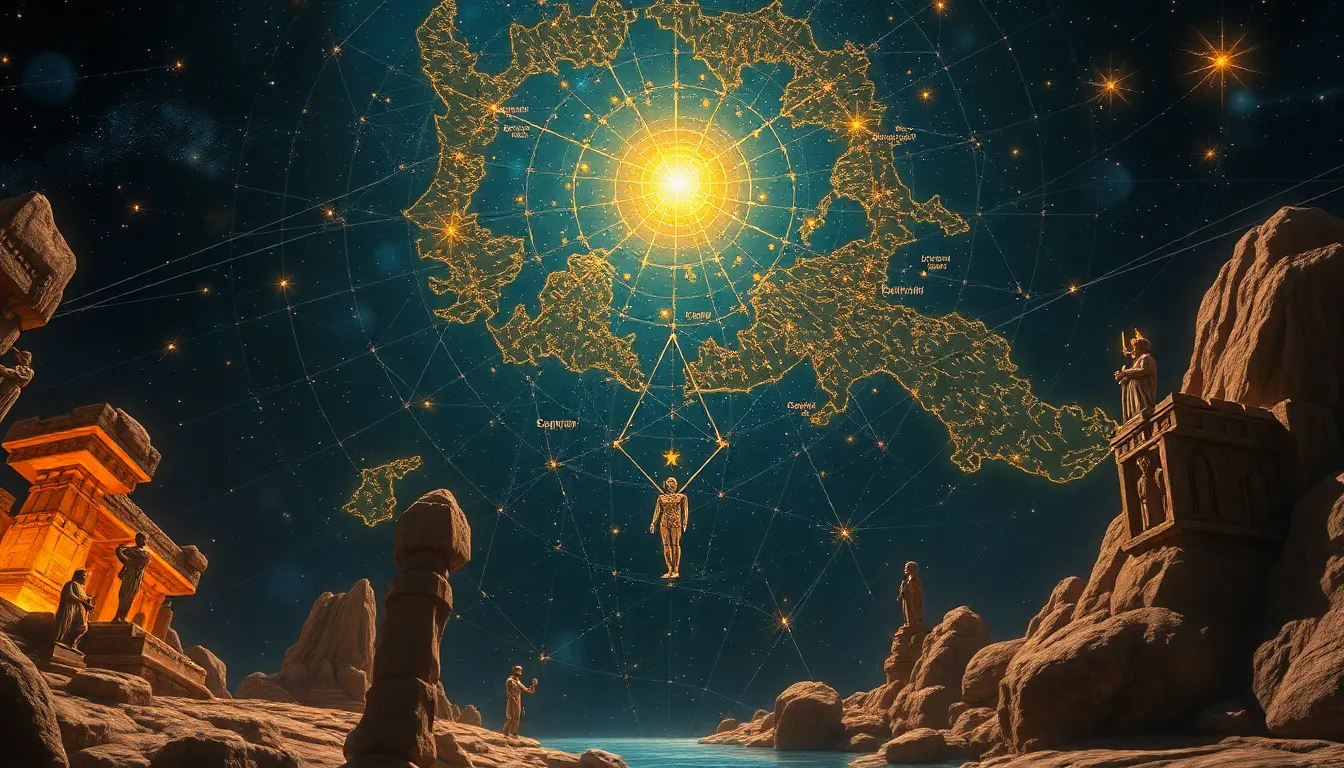The Starry Map of the Underworld: Egyptian Myths of Afterlife Navigation
I. Introduction
Ancient Egyptian civilization is renowned for its rich mythology and profound beliefs about the afterlife. Egyptians viewed death not as an end but as a transition to another existence, and this journey was of paramount importance. The concept of navigation through the afterlife was not merely practical but deeply symbolic, representing the soul’s quest for eternal life.
Central to this journey was the idea of a “Starry Map,” a celestial guide that assisted souls in navigating the complex realm of the afterlife. This article delves into the Egyptian beliefs surrounding the afterlife, the role of celestial navigation, and the myths that illuminate this fascinating aspect of their culture.
II. The Role of the Duat in Egyptian Mythology
The Duat is the Egyptian underworld, a realm where souls journey after death. It is depicted as a vast and intricate landscape that includes rivers, fields, and various challenges that the deceased must face.
- Definition and description of the Duat: The Duat is often described as a dark, mysterious place filled with both dangers and opportunities for rebirth.
- The Duat’s significance: It serves as a transitional space where the soul is judged and either rewarded with eternal life or punished.
- Key deities associated with the Duat:
- Osiris – The god of the afterlife and resurrection.
- Anubis – The god of mummification and the protector of the dead.
- Ma’at – The goddess of truth and justice, who weighs the heart of the deceased against a feather.
III. The Celestial Bodies as Navigational Guides
In ancient Egyptian culture, celestial bodies held immense significance, serving not only as timekeepers but also as guides through the afterlife.
- The importance of stars and constellations: Stars were viewed as the souls of the deceased, with the night sky acting as a map for navigation.
- Specific stars mentioned in Egyptian texts:
- South Star (Alpha Centauri) – Seen as a point of stability and direction.
- Sirius (Sopdet) – Associated with the goddess Isis and the flooding of the Nile, marking the new year.
- The connection between the night sky and the afterlife journey: The alignment of tombs with specific stars was believed to help guide the deceased to their final resting places.
IV. The Journey of the Soul: Key Myths and Texts
Ancient Egyptian texts provide a vivid portrayal of the soul’s journey through the afterlife, often filled with trials and tribulations.
- Overview of the journey of the soul: The soul embarks on a perilous journey through the Duat, facing various challenges that test its worthiness.
- The Book of the Dead: This essential text contains spells and incantations designed to assist the deceased in navigating through the Duat, ensuring a safe passage.
- Notable myths illustrating navigation challenges:
- The story of the sun god Ra, who travels through the Duat each night, facing monsters and obstacles.
- The tale of Osiris and his resurrection, illustrating the importance of guidance and navigation in achieving eternal life.
V. Rituals and Practices for Afterlife Navigation
To ensure a successful journey through the afterlife, ancient Egyptians engaged in various funerary practices.
- Funerary practices: Elaborate burial rituals were performed to prepare the deceased for their journey, including mummification and the inclusion of possessions.
- The significance of tombs and burial artifacts: Tombs were often constructed to mimic the landscapes of the Duat, complete with offerings and artifacts to assist the deceased.
- Incantations and spells: Specific spells from the Book of the Dead were recited to protect the deceased and guide them through the challenges of the afterlife.
VI. Symbolism of the Night Sky in Egyptian Culture
The night sky was imbued with rich symbolism in Egyptian mythology, serving as a source of inspiration and guidance.
- Interpretation of the night sky: Stars were seen as the manifestations of divine beings, representing hope and protection.
- The connection between the stars and divine protection: The alignment of stars and constellations was believed to offer spiritual guidance to the living and the deceased alike.
- Cultural significance of celestial navigation: Beyond the afterlife, the Egyptians used the stars for agricultural planning, navigation, and understanding the cycles of nature.
VII. Comparative Analysis with Other Cultures
Egyptian beliefs about afterlife navigation share similarities and differences with those of other ancient cultures.
- Similarities: Many cultures, such as the Mesopotamians and Greeks, also believed in a navigational aspect to their afterlife journeys, often involving celestial bodies.
- Differences: While Egyptians emphasized the Duat and celestial guidance, other cultures might focus more on judgment or reincarnation.
- The universal theme of navigation: Across cultures, the journey after death often involves overcoming obstacles, highlighting a shared human desire to understand and navigate the unknown.
VIII. Conclusion
The Starry Map in Egyptian mythology serves as a profound reminder of the significance of navigation in the afterlife. Through celestial guidance, the ancient Egyptians crafted a rich tapestry of beliefs that encapsulated their understanding of life, death, and rebirth. These myths continue to influence modern perceptions of the afterlife, reflecting humanity’s enduring quest for meaning beyond mortality.
In reflecting upon these ancient beliefs, we see the importance of navigation as not only a physical journey but also a spiritual one, echoing through the ages in both ancient and contemporary contexts.




